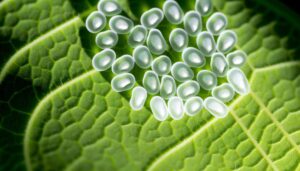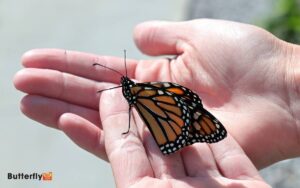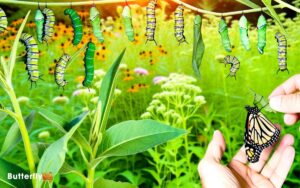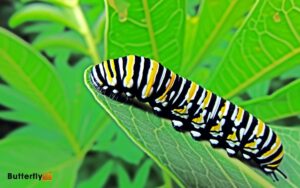Milkweed and Monarch Butterflies Relationship: Explanation!
You need to understand the critical symbiotic relationship between milkweed plants and monarch butterflies to grasp their interdependent survival.
Monarchs rely on milkweed for oviposition and larval nutrition. Females lay around 400 eggs exclusively on milkweed, ensuring immediate nourishment for emerging caterpillars.
Milkweed’s cardenolides are essential for caterpillar sustenance and defense against predators. Significant loss of milkweed habitat has led to a 90% decline in monarch populations over the last 20 years.
Conservation efforts focus on planting native milkweed species to support this intricate life cycle. For a deeper understanding, explore the intricacies of their relationship further.
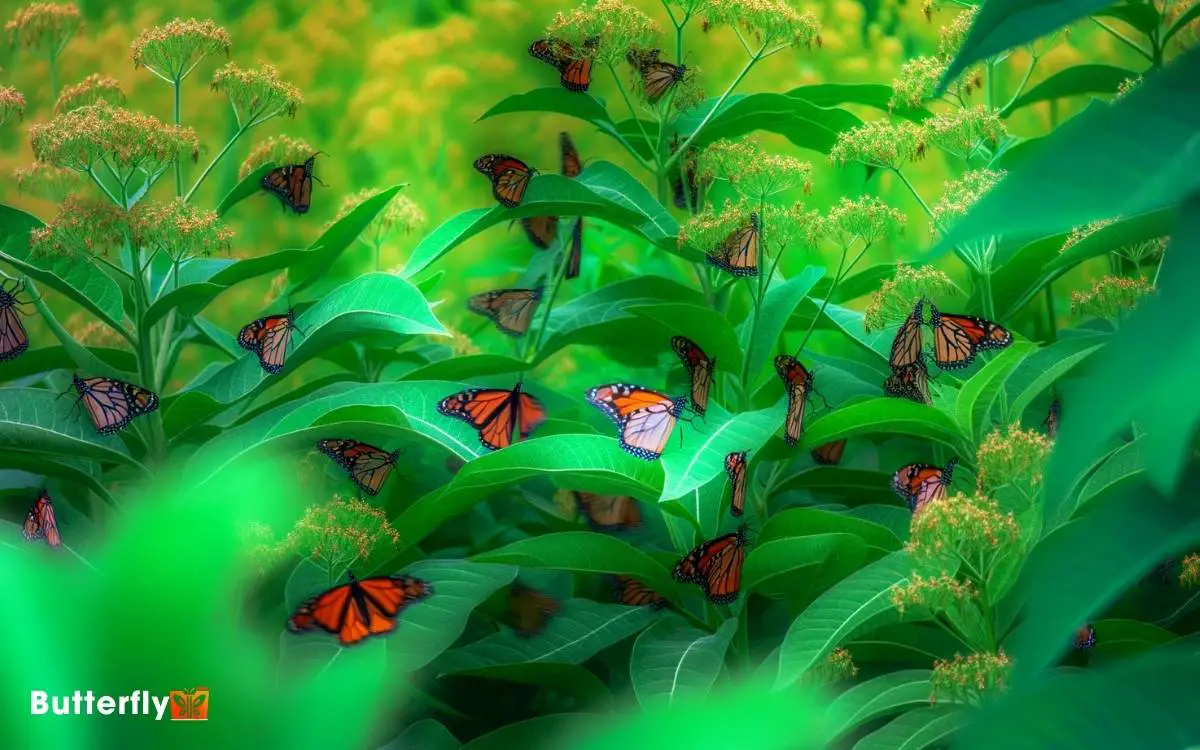
Key Takeaways
Monarch Butterfly Life Cycle
The monarch butterfly (Danaus plexippus) undergoes a remarkable four-stage metamorphosis: egg, larva (caterpillar), pupa (chrysalis), and adult.
In the egg stage, females lay approximately 300-500 eggs, each about 1.2 mm in diameter. Within 3-5 days, larvae hatch and begin consuming milkweed leaves.
The larval stage lasts around 10-14 days, during which caterpillars undergo five instars, or molts, each increasing their weight about 2,700 times.
Following this, they form a chrysalis, entering the pupal stage which lasts 8-15 days. During this period, significant morphological changes occur through histolysis and histogenesis.
Importance of Milkweed
Milkweed’s critical role in the monarch butterfly’s life cycle can’t be overstated, serving as the sole host plant for larval nourishment and adult oviposition.
You’ll find that monarch larvae (caterpillars) exclusively consume milkweed leaves, which provide essential cardiac glycosides for their development and defense against predators. Without milkweed, monarch populations would decline drastically.
Here are four key reasons why milkweed is indispensable:
- Larval Host Plant: Monarch caterpillars rely solely on milkweed for food.
- Chemical Defense: Milkweed’s toxic compounds deter predators.
- Habitat Creation: Milkweed plants support a biodiverse ecosystem.
- Migration Support: Availability of milkweed along migration routes maintains monarch population sustainability.
Understanding these points underscores milkweed’s critical importance in maintaining monarch butterfly populations.
Egg-Laying Process
Monarch butterflies exhibit a highly selective egg-laying behavior, ensuring their larvae have immediate access to milkweed’s essential nutrients upon hatching.
Female monarchs meticulously search for milkweed plants, as these are the only host plants suitable for their offspring. They lay a single egg on the underside of a milkweed leaf, minimizing predation risks and ensuring ideal microclimate conditions.
Here’s a table outlining key egg-laying data:
| Parameter | Value | Notes |
|---|---|---|
| Egg Quantity | ~400 per female | Laid singly |
| Incubation Time | 3-5 days | Temperature-dependent |
| Egg Diameter | ~1.2 mm | Microscopic |
| Host Plant | Milkweed species | Essential for larvae |
| Predation Risk | High | Mitigated by location choice |
This data-driven approach helps you understand the intricate relationship between monarchs and milkweed during the egg-laying phase.
Caterpillar Nutrition
As an essential dietary component, milkweed provides monarch caterpillars with cardenolides, which are chemical compounds that offer both sustenance and a defense mechanism against predators. This pivotal dual role is vital for their survival and development.
When you’re observing the nutritional intake of monarch caterpillars, consider these key points:
- Cardenolides Concentration: Different milkweed species have varying levels of cardenolides, impacting caterpillar growth rates and toxicity.
- Nutrition Absorption: Monarch caterpillars efficiently metabolize milkweed, converting its nutrients into essential proteins and fats.
- Predator Deterrence: Ingested cardenolides make caterpillars distasteful to predators, such as birds and small mammals.
- Developmental Phases: Consistent milkweed consumption allows for smooth progress through the five instar stages, ensuring healthy development.
Understanding these elements helps you appreciate the intricate relationship between milkweed and monarch caterpillars.
Habitat Preservation
Maintaining the natural habitats of monarch butterflies is vital for upholding the ecological balance and ensuring the survival of this migratory species.
You can contribute to habitat preservation by planting native milkweed and wildflowers, which provide essential nectar sources.
Monarchs rely on these plants throughout their life cycle, from larvae to adults. Data shows a 90% decline in monarch populations over the past two decades, emphasizing the urgent need for habitat conservation.
| Impact | Data |
|---|---|
| Population Decline | 90% over 20 years |
| Overwintering Sites | Reduced by 68% |
| Breeding Grounds Lost | 165 million acres |
| Migration Distance | Up to 3,000 miles |
| Nectar Plant Species | Over 30 species required |
Threats to Monarchs
Numerous threats, including habitat loss, pesticide use, and climate change, critically endanger monarch butterfly populations.
You need to understand these key threats to appreciate the urgency of the situation:
- Habitat Loss: Deforestation and urban development reduce milkweed availability, essential for monarch reproduction.
- Pesticide Use: Neonicotinoids and other pesticides kill milkweed and directly harm monarch larvae.
- Climate Change: Altered weather patterns disrupt migration and breeding cycles, leading to population declines.
- Disease and Parasites: Pathogens like Ophryocystis elektroscirrha (OE) weaken and kill monarchs, exacerbating other threats.
These factors collectively threaten Danaus plexippus survival, emphasizing the need for immediate, informed action to protect this iconic species.
Conservation Efforts
Recognizing these threats, conservation efforts are being implemented to restore milkweed habitats, regulate pesticide use, and mitigate climate impacts to support monarch butterfly populations.
You can contribute by planting Asclepias species, such as Asclepias syriaca and Asclepias tuberosa, which are essential for monarch reproduction.
Data shows a 90% decline in monarch populations over the past two decades, highlighting the urgency. Organizations like Monarch Watch provide milkweed seeds for restoration projects.
Integrated Pest Management (IPM) strategies are recommended to reduce harmful pesticide exposure. Climate models indicate shifting migration patterns; therefore, adaptive management is critical.
Conclusion
You can’t overstate the vital bond between monarch butterflies and milkweed. Without milkweed, monarchs face extinction; their larvae are utterly dependent on its leaves.
Picture a world devoid of these glorious insects fluttering through fields. It’s not hyperbole—habitat loss and pesticides are obliterating this relationship.
Conservationists are racing against time, planting milkweed, creating sanctuaries.
You’ve got to act now to save these winged jewels from vanishing forever, ensuring a future where monarchs thrive.



